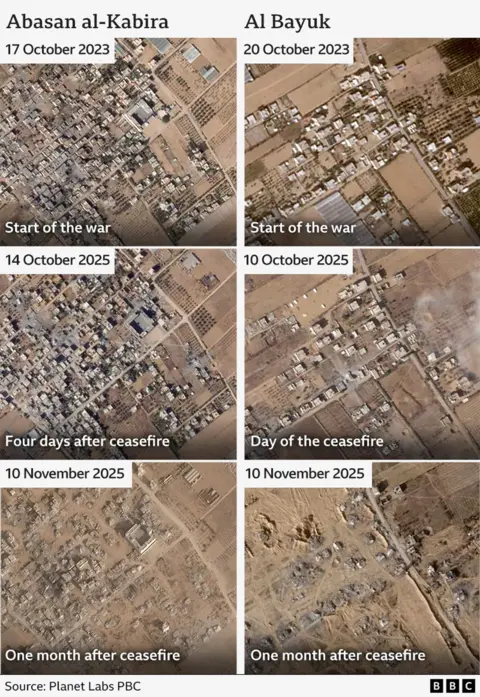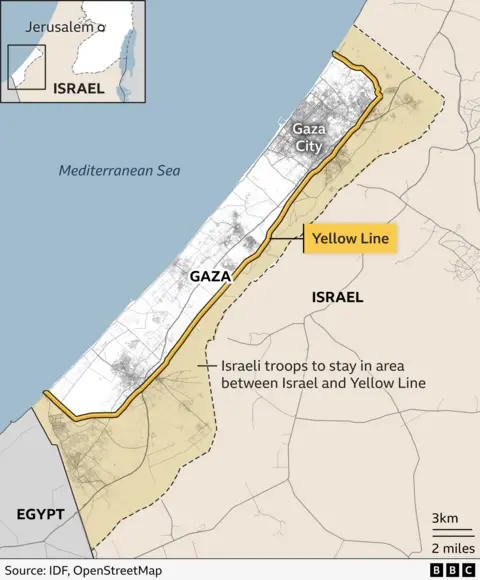Israel has destroyed more than 1,500 buildings in Gaza since ceasefire

Benedict Garman,BBC Verify and
Barbara Metzler,BBC Verify
 BBC
BBCIsrael has destroyed more than 1,500 buildings in areas of Gaza that have remained under its control since the ceasefire with Hamas started on 10 October, satellite images reviewed by BBC Verify show.
The new photos – the latest of which was taken on 8 November – show that entire neighbourhoods controlled by the Israel Defense Forces (IDF) have been levelled in less than a month, apparently through demolitions.
The actual number of destroyed buildings could be significantly higher, with satellite imagery for some areas being unavailable for BBC Verify’s assessment.
Some experts have argued that the demolitions may violate the terms of the ceasefire brokered by the US, Egypt, Qatar and Turkey. But an IDF spokesperson told BBC Verify that it was acting “in accordance with the ceasefire framework”.
US President Donald Trump’s 20 point peace plan for Gaza – the basis for the ceasefire – stated “all military operations, including aerial and artillery bombardment, will be suspended”. He has since repeatedly stated that “the war is over”.
BBC Verify’s visual analysis of satellite imagery has found that the destruction of buildings in Gaza by the Israeli military has been continuing on a huge scale. We used a change detection algorithm to analyse radar images taken before and after the ceasefire to highlight changes, which might indicate destruction, then manually counted visibly destroyed buildings.
We looked at buildings destroyed behind the Yellow Line – a boundary running along the north, south and east of Gaza. Under October’s ceasefire deal Israel agreed to withdraw its forces to that marker, annotated by a yellow line on maps released by the IDF.
Houses, orchards and gardens flattened
Many of the razed buildings did not appear to be damaged prior to being destroyed, for example, in eastern Khan Younis, around Abasan al-Kabira.
It’s hard to be conclusive from a satellite image taken from above, but these buildings did not have visible damage to their structure or tell tale signs like nearby rubble or changes to their outlines. There were houses with gardens, trees and some small orchards.
A comparison between satellite images of this area captured at the start of the war in October 2023 with images captured around the date of the ceasefire shows little change to many buildings.

Lana Khalil used to live in Abasan al-Kabira before she was displaced to nearby al-Mawasi. She described her home as being a “heaven” and full of “farms and vegetables”.
Now, like so many other parts of Gaza, the area has been reduced to rubble.
“The Israeli military left nothing to us, they demolished everything,” she said. Ms Khalil added that former residents could hear the demolition of the area “from our tents in al-Mawasi”.
“Our hearts are broken,” she said.
In another area, near al-Bayuk, east of the city of Rafah, satellite imagery tells the same story. Numerous buildings that seemed from above to be undamaged before the ceasefire have since been destroyed. Aerial footage of a huge explosion published at the start of November shows dust rising from the ruins of the neighbourhood.
Destruction has also continued in Gaza City itself, in the eastern neighbourhood of Shejaiya as well as near the Indonesian hospital on the edge of Jabalia camp.
Eitan Shamir, ex-head of the National Security Doctrine Department in the Israel Ministry of Strategic Affairs, suggested that the IDF’s actions were not a violation of the ceasefire terms, arguing that they don’t apply to areas of the Strip behind the Yellow Line.
Verified videos showing controlled demolitions and excavators tearing down buildings published to social media since the ceasefire have also been geolocated to areas behind the Yellow Line.

Demolitions a ‘violation of ceasefire’
The IDF has defended its actions and a spokesperson said: “According to the agreement, all terror infrastructure, including tunnels, is to be dismantled throughout Gaza. Israel is acting in response to threats, violations, and terror infrastructure.”
On 18 October, Israel’s Defence Minister Israel Katz wrote on X that “demilitarizing Gaza by destroying the terror tunnels and all terror infrastructure” was a “clear” part of Israel’s security policy.
Point 13 of Trump’s peace plan published by the White House – the closest thing to publicly released terms of the ceasefire – stated that all “military, terror, and offensive infrastructure, including tunnels and weapon production facilities, will be destroyed and not rebuilt”.
But it also states the process of demilitarisation of Gaza will be “under the supervision of independent monitors”.
“This is definitely a violation of the ceasefire,” said Dr H A Hellyer, a RUSI Senior Associate Fellow. “But [Washington] DC is unwilling to recognise it as such, insisting that the ceasefire has to hold, even when it isn’t actually holding.”
But Mr Shamir denied the IDF was breaching the ceasefire. He told BBC Verify that according to his sources within the IDF there was a view that: “Hamas is allowed to do what it wants in the territory it controls, and Israel is allowed to do what it wants in the territory it controls.”
The IDF was taking the view that it was unlikely Hamas would follow through with the second stage of the agreement, according to his sources.
“Therefore, the space must be prepared for the continuation of the fighting, so as not to leave [them] any options to ambush our soldiers.” He also said that there were frequent attempts by Hamas to infiltrate beyond the Yellow Line and that there were still long sections of tunnel to be dealt with.
Some analysts – such as Adil Haque, professor of law at Rutgers University – said Israel could be violating the laws of war, which prohibit the destruction of civilian property by an occupying power.
He noted that exceptions to the rule can only arise “from military operations, that is, from combat or direct preparations for combat,” arguing that during a ceasefire “it is not plausible that such significant destruction of civilian property has been rendered absolutely necessary by military operations”.
Hugh Lovatt, Senior Policy Fellow at the European Council on Foreign Relations, said ultimately the demolitions could jeopardise the peace plan.
“The problem of Israeli demolitions will grow the longer Israel stays in the zone behind the Yellow Line.
“Ultimately, the sense that Israel is stalling its withdrawal and looking to create new permanent facts on the ground, as it has in the West Bank, will become an increasingly greater threat to the maintenance of the ceasefire.”
Additional reporting by Alex Murray

Source link


